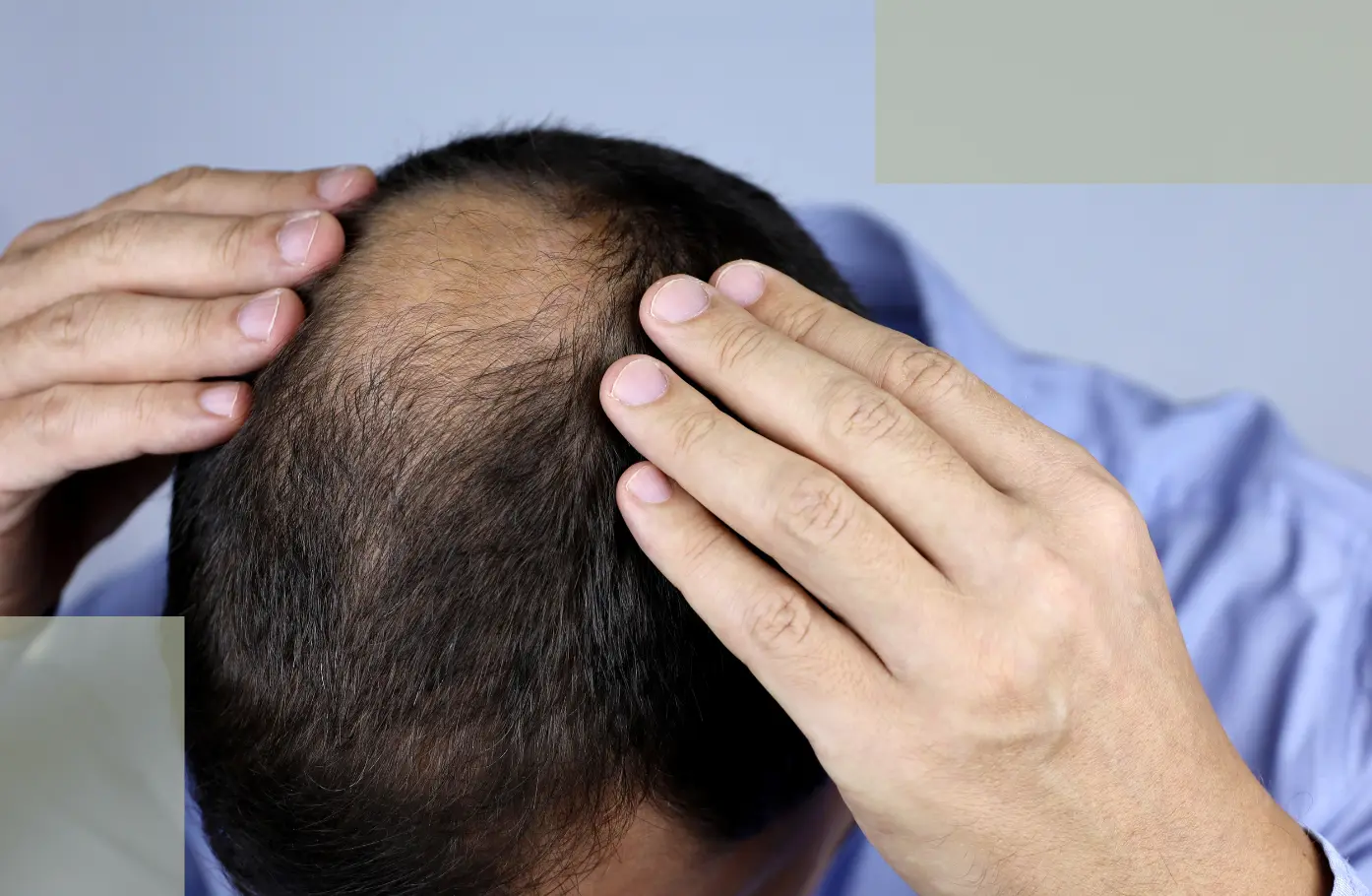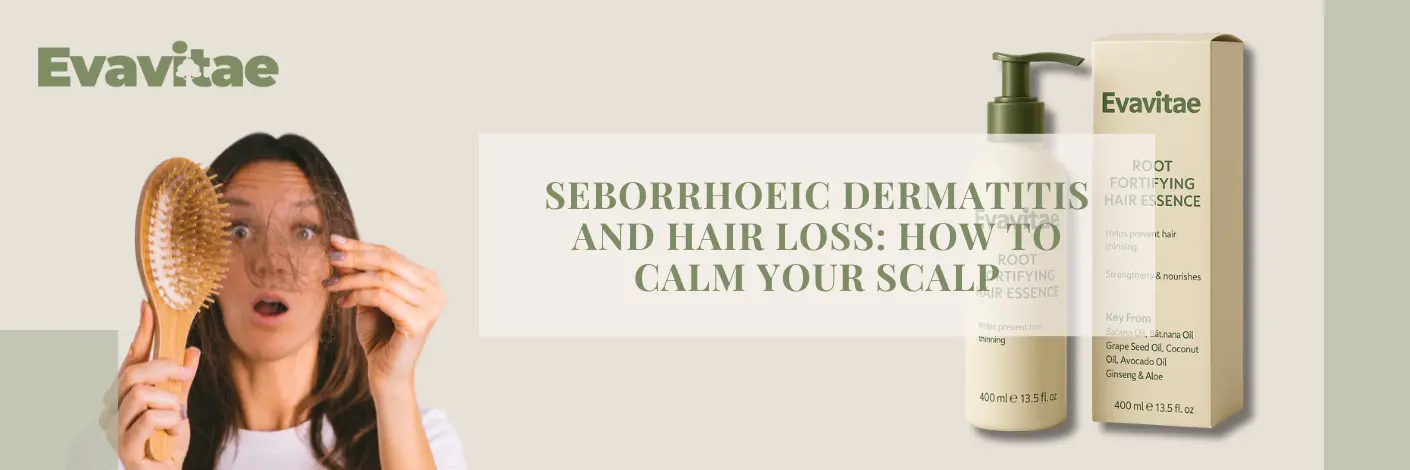
Seborrhoeic dermatitis is a chronic, inflammatory skin condition that commonly affects the scalp. Characterized by redness, flaking, itching, and greasy patches, it can lead to distress not only due to physical discomfort but also due to its connection to hair loss. If you’ve been experiencing increased shedding alongside a sensitive, inflamed scalp, seborrhoeic dermatitis may be the culprit.
In this article, we’ll explore how seborrhoeic dermatitis may contribute to hair loss, how to distinguish it from other scalp conditions, and what gentle hair care strategies may help soothe the scalp and reduce the impact on hair growth.
🔍 What Is Seborrhoeic Dermatitis?
Seborrhoeic dermatitis (SD) is a common form of eczema that typically affects areas rich in sebaceous glands—like the scalp, eyebrows, sides of the nose, and behind the ears. It’s thought to be caused by a combination of factors, including:
- Overgrowth of Malassezia yeast on the skin
- Excess oil production by the sebaceous glands
- An inflammatory immune response
- Genetic predisposition
While not contagious, seborrhoeic dermatitis often recurs and may flare due to stress, weather changes, or hormonal shifts.
🧠 How Does Seborrhoeic Dermatitis Cause Hair Loss?
Seborrhoeic dermatitis does not directly damage hair follicles, but its inflammation creates an unhealthy scalp environment. Here’s how it can impact hair growth:
1. Inflammation and Hair Shedding
Chronic inflammation can lead to hair follicles entering the telogen (shedding) phase prematurely, resulting in diffuse thinning or patches of hair loss (Picciani et al., 2015).
2. Scratching and Trauma
Persistent itching can cause people to scratch the scalp frequently, damaging both the skin barrier and hair follicles, which may lead to hair breakage or traction-related hair loss.
3. Pore Blockage and Follicle Stress
Seborrhoeic dermatitis often causes excess sebum and skin cell buildup, clogging follicles and hindering healthy hair growth cycles (Jafferany et al., 2016).
Once scalp inflammation begins to subside, it’s important to shift into a healing phase. Explore how to create a gentle restorative routine for scalp repair—one that balances cleansing with nourishment to rebuild scalp resilience and reduce future flare-ups.
🔬 How to Recognize Seborrhoeic Dermatitis (vs. Dandruff)
While dandruff and seborrhoeic dermatitis share similar traits—such as flaking and itching—seborrhoeic dermatitis tends to be more inflamed, persistent, and oily. You may notice:
- Yellowish, greasy flakes
- Scalp redness or raw spots
- Itching and tenderness
- Eyebrow or facial flaking
Unlike psoriasis (which often causes silver plaques), SD is more subtle but persistent.
🧴 Gentle Scalp Care Strategies for Seborrhoeic Dermatitis
If you suspect seborrhoeic dermatitis is behind your scalp discomfort and hair loss, you don’t need to panic. With consistent, gentle care, most people see significant improvement. Here’s what can help:
✅ 1. Use a Mild, Fragrance-Free Shampoo
Choose a sulfate-free shampoo that doesn’t irritate the skin barrier(try Evavitae). Look for formulas that are free from harsh surfactants and artificial fragrance(click here to view Evavitae’s ingredient list).
🌿 Tip: Shampoos containing natural anti-inflammatory ingredients like batana oil can offer gentle relief and moisture without triggering flare-ups.
Batana oil is rich in essential fatty acids and tocopherols (vitamin E), which can support the scalp’s barrier and reduce oxidative stress. Anecdotally used in Central American cultures, it’s now gaining scientific interest for its emollient properties (Zhao et al., 2022).
✅ 2. Try Medicated Shampoos—With Caution
Ingredients like ketoconazole, zinc pyrithione, or selenium sulfide are commonly used to manage yeast overgrowth. However, frequent use may cause scalp dryness or irritation.
🔄 Rotate medicated shampoo use with gentle, moisturizing formulas(such as Evavitae) to balance treatment with nourishment.
✅ 3. Moisturize and Calm the Scalp
Apply lightweight, non-comedogenic oils like grapeseed, jojoba, or batana oil to hydrate the scalp without clogging pores. Avoid essential oils unless you’re certain they won’t irritate sensitive skin.
✅ 4. Avoid Triggers and Stress
Stress and lack of sleep are known triggers for flare-ups. A few tips:
Stick to a regular hair-washing routine (2–3 times/week)
Avoid overwashing or overwearing tight hairstyles
Practice stress management techniques like meditation or journaling
✅ 5. Consult a Dermatologist If Symptoms Persist
Persistent symptoms or scalp pain that worsens may require medical treatment, including topical corticosteroids or antifungal solutions. Always consult with a healthcare professional if symptoms don’t improve within 4–6 weeks of gentle care.
🍽️ Does Diet Matter?
Emerging research suggests that a diet high in anti-inflammatory foods (like omega-3 fatty acids, leafy greens, and zinc-rich seeds) can help reduce overall inflammation—including in the scalp (Linus Pauling Institute, 2022). While not a cure, supporting your body from the inside out can assist your recovery.
🙋♀️ Frequently Asked Questions
Q: Can seborrhoeic dermatitis hair loss grow back?
A: Yes—hair usually regrows once inflammation subsides and scalp health improves. Timely care is key.
Q: Is seborrhoeic dermatitis permanent?
A: It can be chronic, but manageable. With consistent care and reduced triggers, many people experience long-term control.
Q: Can I dye my hair if I have seborrhoeic dermatitis?
A: It’s best to avoid harsh chemical treatments during flare-ups. Consult your dermatologist before dyeing.
❤️ Final Thoughts
Seborrhoeic dermatitis can be frustrating—especially when it causes hair loss—but you’re not powerless. By gently caring for your scalp, managing triggers, and choosing nurturing ingredients like batana oil, you can restore balance and support healthy hair growth.
Patience, consistency, and scalp-friendly routines go a long way. And always remember: healthy hair starts at the root—literally.
When dealing with scalp inflammation or medical-related shedding, a calm and consistent routine makes all the difference. See how to care for post-chemo hair and soothe scalp sensitivity with gentle products and slow, restorative practices that nurture healthy regrowth.
🌸 Keep building a healthy hair routine with step-by-step tips in our Scalp Care & Routine Hub.
For practical tips and product advice, explore the Full Postpartum Hair Loss Resource.
📚 References (APA Format)
Jafferany, M., Huynh, T. N., & Silverman, M. A. (2016). Seborrheic dermatitis: a review of epidemiology, etiology, pathogenesis, and treatment. Dermatology Clinics, 34(3), 361–372. https://doi.org/10.1016/j.det.2016.02.002
Linus Pauling Institute. (2022). Micronutrients and Inflammation. Retrieved from https://lpi.oregonstate.edu/mic
Picciani, B. L. S., et al. (2015). Inflammatory skin disorders and their link to hair loss: The role of cytokines and immune mediators. Skin Appendage Disorders, 1(4), 158–165. https://doi.org/10.1159/000441937
Zhao, L., Wang, Y., & Lin, X. (2022). Batana oil: Traditional use and modern potential for skin and hair care. Journal of Ethnopharmacology, 287, 115012. https://doi.org/10.1016/j.jep.2022.115012
Evavitae products are now available exclusively at www.evavitae.com.




Add comment
You must be logged in to post a comment.